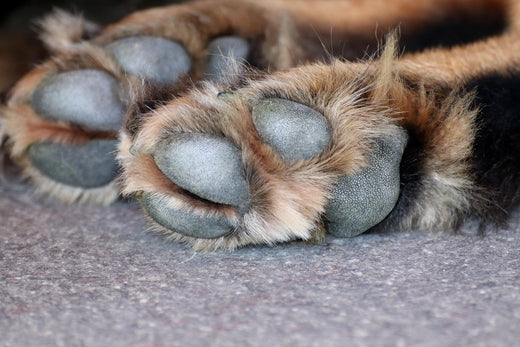
Cracked Paws 101
Many dog paw pads naturally feel a little rough, which is no surprise considering the rugged terrains they walk on every day. Paw pads have a thick layer of pigmented skin with insulating fatty tissue underneath, protecting them from cold, hot, and rough surfaces. However, no dog is invincible, and sometimes extreme weather conditions like cold air or icy surfaces can make paw pads dry out and crack. Dry dog paws are one of the most common paw pad injuries and should always be taken seriously. If untreated, it can become painful and potentially lead to infection. If you've ever experienced cracked hands yourself, you'll know how uncomfortable the sensation is. Canines feel this discomfort too, but worse so, as they are constantly applying pressure to the cracked areas every time they walk. Therefore, it can quickly become a painful condition.Symptoms of Cracked Paws
It's easy to spot dry dog paws, both from their look and feel and your pup's behavior. Here are the most common symptoms.- Rough and dry texture
- Excessive scratching
- Inflammation and redness
- Excessive licking and chewing
- Limping or trouble when walking on hard and hot surfaces
- Slight bleeding may also be present
Cracked Paws Causes
Your dog's paw pads can become rough at any time of the year and for various reasons, not all of which are weather-related.- Dry air - This is the most common cause of cracked paw pads, affecting canines the same way as humans. If you use air conditioning during the summer and your pup stays indoors, you might notice their paws start drying out. After summer, the same thing can happen when the outside air gets colder and drier
- Allergic reactions - Food allergies typically show up on the feet via the common symptom of itchy feet. The irritation causes the pup to chew and lick their feet, which dries them out and leads to cracking. Dogs can be allergic to a wide range of food, such as dairy, beef, lamb, chicken, eggs, soy, or gluten. However, some breeds are more susceptible to allergies, including Dachshunds, Bulldogs, Golden Retrievers, and German Shepherds.
- Poor diet - If a dog does not get all the minerals and nutrients they need through their food, their skin can become dry and, over time, lead to cracking. Zinc is one of the most needed minerals for the skin. It prevents chapping and crusting, but it also aids in wound healing.
- Contact with chemicals - Unfortunately, we cannot always see toxic chemicals on surfaces, so we cannot prevent our dogs from walking over them. This could be something outdoors, but the chemicals in many home floor cleaners can also be toxic to dogs, causing itching and dryness.
- Hot and cold weather - In the middle of a hot summer's day, the pavements can be scorching and burn or blister the sensitive paw pads. Similarly, snowy and icy surfaces in winter are among the most common causes of chapped, cold paws.
- Underlying diseases - Occasionally, a dog's paws become rough due to something more serious. For example, autoimmune diseases, hormonal imbalances, and endocrine-related issues lower the immune response, resulting in dry and cracked dog paws. In addition, liver problems can affect how well a dog absorbs nutrition, leaving them nutrient deficient and at risk.
Treatment and Prevention
Both the treatment and prevention of dry paws follow a similar formula. So whether your dog already has cracked paw pads or you just want to keep them in good condition, here's how to approach it.- Moisturize with a paw balm or cream - There are many paw balms and creams on the market specially designed for this sensitive part of the body. They contain anti-inflammatory ingredients to help soothe dry skin, and many have natural formulas. However, some dogs will try to lick it off before it takes effect, so choosing a non-scented and tasteless paw balm is best. Only use products made specifically for canines, as human creams could contain toxic ingredients.
- Massage with oil - Coconut oil is deeply moisturizing and ideal for soothing and replenishing dry, chapped skin. It's also safe for your pup to lick off, and most dogs love the flavor! Olive oil also adds moisture to the skin, particularly when warm. It is full of beneficial fatty acids and vitamins E and K.
- Avoid walking your dog on rough surfaces - Rocky surfaces are more likely to cause cuts and chaps than softer terrains like grass and mud. Be wary of hot pavement and sand during the summer too.
- Use dog booties - If you live somewhere with extreme winters or summers, you might want to consider getting your pup some booties. That way, your fluffy friend can still get plenty of walks no matter the weather.
- Trim hair tufts around the toes - Some dogs grow tufts of hair in between the toes. Although it looks cute, these hairs may mat holding water and bacteria , which can dry out the paw pads.
- Consider supplements - If your pup has had dry paws on more than one occasion, you might want to get a skin and fur supplement to boost their immune system. These supplements contain nutrients essential to skin health, like Zinc and Vitamin E.
Shop LuckyTail AllerImmune Chews
If your dog's cracked pads look severe, such as if you notice bleeding or deep cracks, you’ll need to give them some extra attention. First, clean them with dog-safe soap and warm water. After paw cleaning, dry thoroughly and apply a layer of antibiotic or antibacterial ointment or gel to prevent infection. You may also want to bandage the paw to prevent further damage and help it heal faster.
